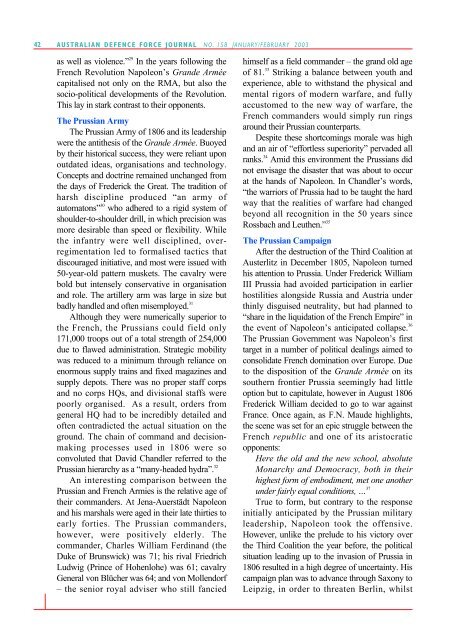ISSUE 158 : Jan/Feb - 2003 - Australian Defence Force Journal
ISSUE 158 : Jan/Feb - 2003 - Australian Defence Force Journal
ISSUE 158 : Jan/Feb - 2003 - Australian Defence Force Journal
You also want an ePaper? Increase the reach of your titles
YUMPU automatically turns print PDFs into web optimized ePapers that Google loves.
42<br />
AUSTRALIAN DEFENCE FORCE JOURNAL NO. <strong>158</strong> JANUARY/FEBRUARY <strong>2003</strong><br />
as well as violence.” 29 In the years following the<br />
French Revolution Napoleon’s Grande Armée<br />
capitalised not only on the RMA, but also the<br />
socio-political developments of the Revolution.<br />
This lay in stark contrast to their opponents.<br />
The Prussian Army<br />
The Prussian Army of 1806 and its leadership<br />
were the antithesis of the Grande Armée. Buoyed<br />
by their historical success, they were reliant upon<br />
outdated ideas, organisations and technology.<br />
Concepts and doctrine remained unchanged from<br />
the days of Frederick the Great. The tradition of<br />
harsh discipline produced “an army of<br />
automatons” 30 who adhered to a rigid system of<br />
shoulder-to-shoulder drill, in which precision was<br />
more desirable than speed or flexibility. While<br />
the infantry were well disciplined, overregimentation<br />
led to formalised tactics that<br />
discouraged initiative, and most were issued with<br />
50-year-old pattern muskets. The cavalry were<br />
bold but intensely conservative in organisation<br />
and role. The artillery arm was large in size but<br />
badly handled and often misemployed. 31<br />
Although they were numerically superior to<br />
the French, the Prussians could field only<br />
171,000 troops out of a total strength of 254,000<br />
due to flawed administration. Strategic mobility<br />
was reduced to a minimum through reliance on<br />
enormous supply trains and fixed magazines and<br />
supply depots. There was no proper staff corps<br />
and no corps HQs, and divisional staffs were<br />
poorly organised. As a result, orders from<br />
general HQ had to be incredibly detailed and<br />
often contradicted the actual situation on the<br />
ground. The chain of command and decisionmaking<br />
processes used in 1806 were so<br />
convoluted that David Chandler referred to the<br />
Prussian hierarchy as a “many-headed hydra”. 32<br />
An interesting comparison between the<br />
Prussian and French Armies is the relative age of<br />
their commanders. At Jena-Auerstädt Napoleon<br />
and his marshals were aged in their late thirties to<br />
early forties. The Prussian commanders,<br />
however, were positively elderly. The<br />
commander, Charles William Ferdinand (the<br />
Duke of Brunswick) was 71; his rival Friedrich<br />
Ludwig (Prince of Hohenlohe) was 61; cavalry<br />
General von Blücher was 64; and von Mollendorf<br />
– the senior royal adviser who still fancied<br />
himself as a field commander – the grand old age<br />
of 81. 33 Striking a balance between youth and<br />
experience, able to withstand the physical and<br />
mental rigors of modern warfare, and fully<br />
accustomed to the new way of warfare, the<br />
French commanders would simply run rings<br />
around their Prussian counterparts.<br />
Despite these shortcomings morale was high<br />
and an air of “effortless superiority” pervaded all<br />
ranks. 34 Amid this environment the Prussians did<br />
not envisage the disaster that was about to occur<br />
at the hands of Napoleon. In Chandler’s words,<br />
“the warriors of Prussia had to be taught the hard<br />
way that the realities of warfare had changed<br />
beyond all recognition in the 50 years since<br />
Rossbach and Leuthen.” 35<br />
The Prussian Campaign<br />
After the destruction of the Third Coalition at<br />
Austerlitz in December 1805, Napoleon turned<br />
his attention to Prussia. Under Frederick William<br />
III Prussia had avoided participation in earlier<br />
hostilities alongside Russia and Austria under<br />
thinly disguised neutrality, but had planned to<br />
“share in the liquidation of the French Empire” in<br />
the event of Napoleon’s anticipated collapse. 36<br />
The Prussian Government was Napoleon’s first<br />
target in a number of political dealings aimed to<br />
consolidate French domination over Europe. Due<br />
to the disposition of the Grande Armée on its<br />
southern frontier Prussia seemingly had little<br />
option but to capitulate, however in August 1806<br />
Frederick William decided to go to war against<br />
France. Once again, as F.N. Maude highlights,<br />
the scene was set for an epic struggle between the<br />
French republic and one of its aristocratic<br />
opponents:<br />
Here the old and the new school, absolute<br />
Monarchy and Democracy, both in their<br />
highest form of embodiment, met one another<br />
under fairly equal conditions, … 37<br />
True to form, but contrary to the response<br />
initially anticipated by the Prussian military<br />
leadership, Napoleon took the offensive.<br />
However, unlike the prelude to his victory over<br />
the Third Coalition the year before, the political<br />
situation leading up to the invasion of Prussia in<br />
1806 resulted in a high degree of uncertainty. His<br />
campaign plan was to advance through Saxony to<br />
Leipzig, in order to threaten Berlin, whilst

















